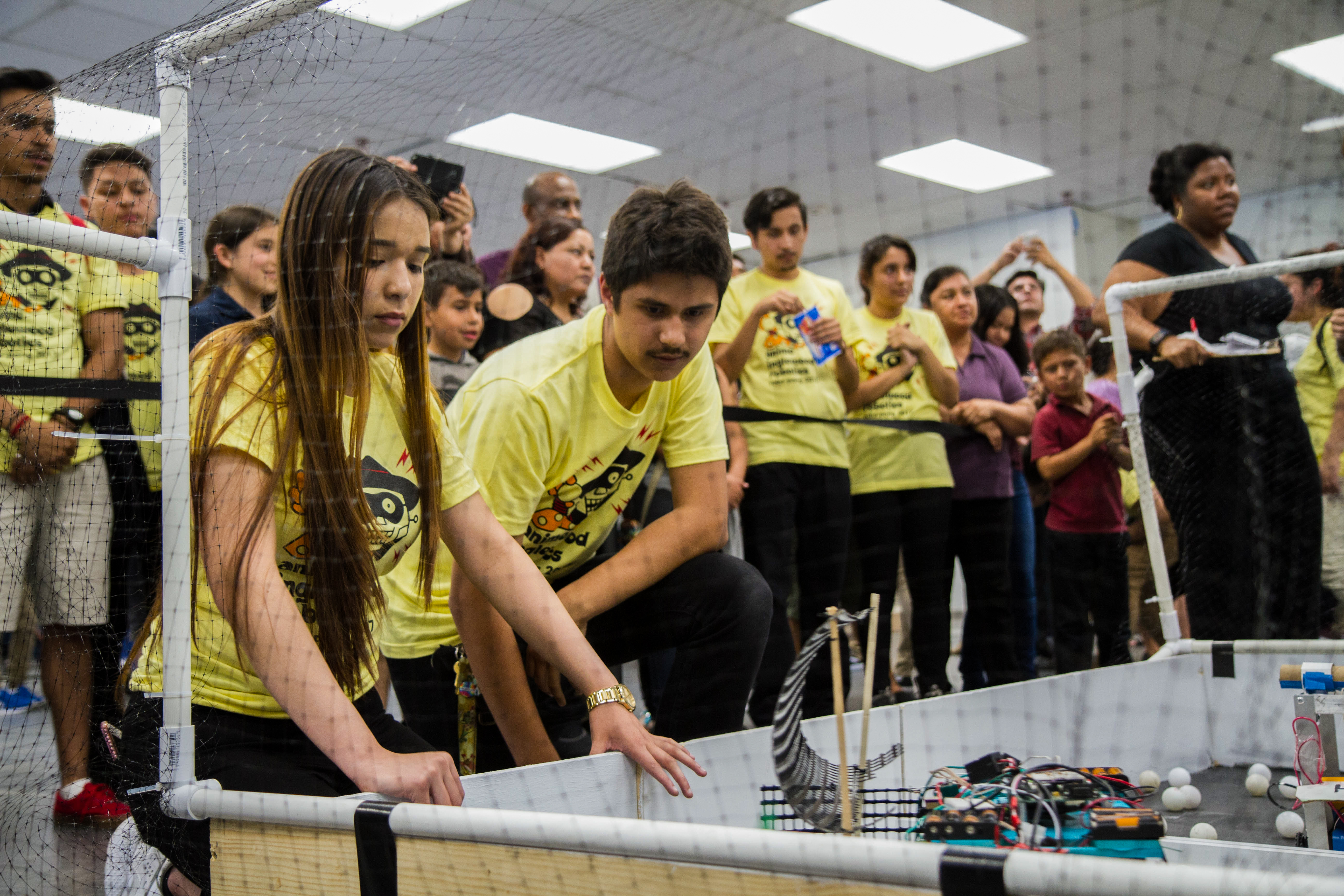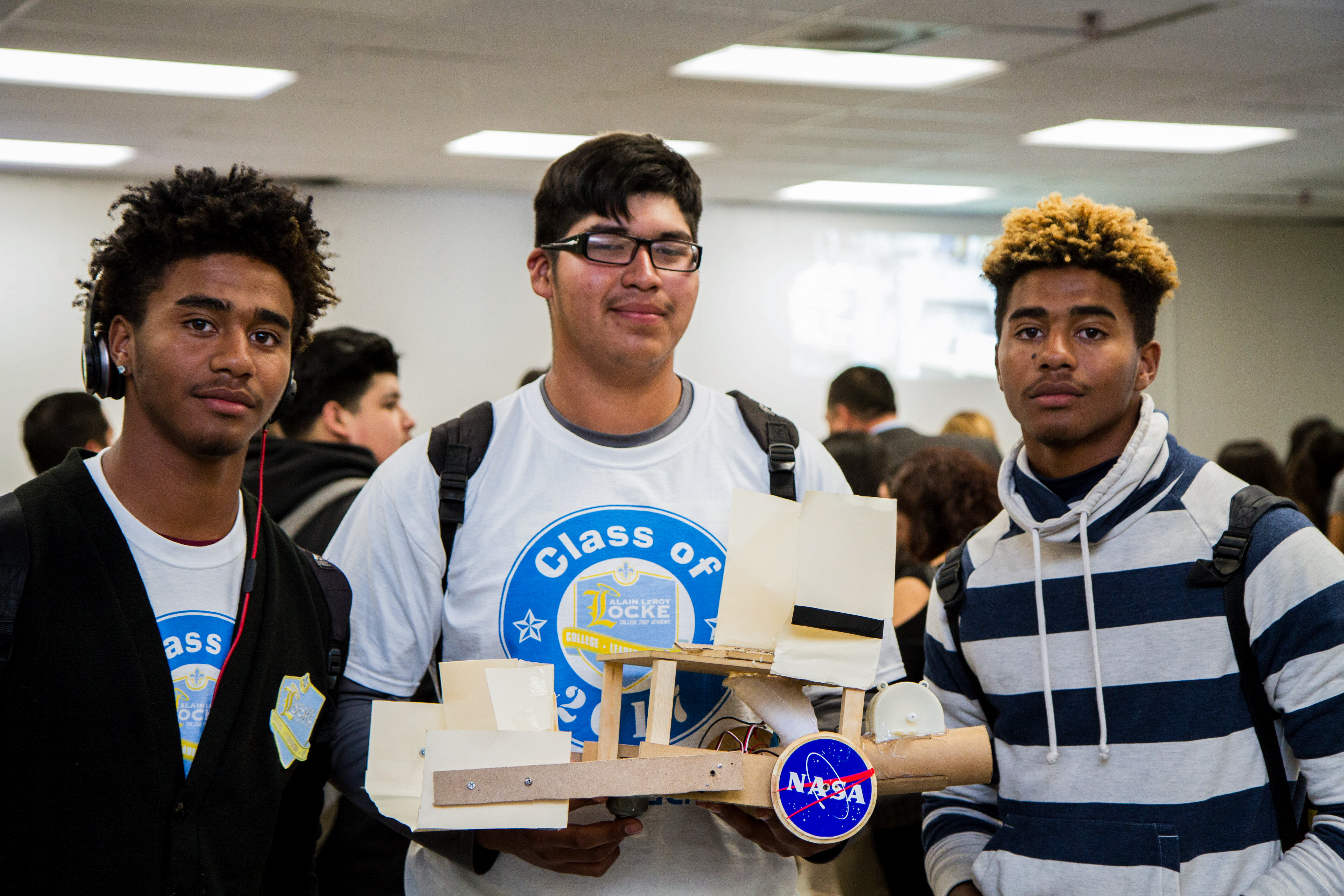Robotics: It’s Not All Nuts and Bolts
Close to 300 students, staff, and family buzzed about Ánimo Inglewood Charter High School, waiting for the third annual Green Dot Robotics Competition to begin. A feeling of camaraderie filled the room as students from five different Green Dot schools shared feelings of anxiousness and pride. For these budding robotics engineers, the evening was a test of their creations and a celebration of their accomplishments. “Robotics is really about teamwork. Obviously we would like our robot to win, but we’ll be okay if it doesn’t, because we’re here supporting each other,” said Melissa Zepeda, junior at Ánimo Leadership Charter High School.

At this year’s competition, high school participants competed to see whose pre-programmed, autonomous robot could throw the most ping pong balls in the other’s goal. Middle school competitors had a timed trial through a driving course. Students from Tom Rice’s class at Ánimo Inglewood took first, second, and third place, defeating over 50 robots to win. Seventh grader Adam Russell and eighth grader Jerin Philip from Yale Minn’s class at Ánimo Westside Charter Middle School won the driving course.
Robotics: A Blueprint
In 2009, Green Dot Public Schools’ robotics program was an idea in the mind of one high school science teacher. Eight years later, hundreds of students throughout the Green Dot network are learning how to meet the challenges of the future by building their own robots. Furthermore, they’re competing with students from other Green Dot schools in an epic and annual “Battle of the Bots.”
The program started when Ánimo Pat Brown Charter High School science teacher Andrew Osterhaus saw a need for an additional elective course, thinking a robotics course would be a great experience for students. “I did my research and looked into different robotics programs, but nothing quite fit. I wanted a program where all students were engaged in the programming, problem solving, and the mechanical or electrical engineering,” said Osterhaus. “So I created my own program that was personal, more focused, and allowed every student to be hands-on.”

The goal wasn’t to create just another science class, but rather a class that taught soft skills while working through high level challenges. “At Green Dot, our robotics program isn’t entirely about teaching science. It’s focused on having all students fully participate, so they’re learning how to problem solve, how to effectively collaborate and how to work through failure,” said Osterhaus. “As our students continue their academic careers, they’re going to experience failure, but we want them to persevere, learn from that experience, and be able to find success.”
Passing the Torch
Osterhaus’ vision resonated with Ánimo Leadership physics teacher Steven Skoropad, and Ánimo Inglewood physics teacher Tom Rice,who taught the winning students. Both educators brought the curriculum to their schools and have worked closely with Osterhaus to grow and strengthen the program. Once they were teaching their students, they knew establishing connections to other students would improve the course and motivate their students.
So they worked together to create an experience that would allow students to take key learnings from the robotics curriculum and apply it to a large scale project. This project became the Green Dot Robotics Competition, a science, technology, engineering and math (STEM) showcase where students build autonomous robots capable of completing complex tasks without human assistance.

“From its inception, it was my hope that the program would grow,” said Osterhaus. “So throughout the years, when anyone has shown interest in teaching robotics, we’ve quickly got them the materials, then trained and supported them.”
When Osterhaus decided to become a founding teacher at Green Dot’s new middle school located near Ánimo Pat Brown, Ánimo Florence-Firestone Charter Middle School, he passed the robotics torch to Skoropad and Rice to lead the network-wide competition.
“We owe it to our predecessor, Andy Osterhaus, to provide a space where students learn problem solving, empathy, and teamwork skills that students don’t often get enough of,” said Rice.
The Next Generation
This year, through collaboration with Skoropad and Rice, Yale Minn’s technology students at Ánimo Westside Charter Middle School participated in the robotics competition for the first time.
“Participating in the competition is a great opportunity for our middle school students to challenge themselves,” said Minn. “Being exposed to the high school students’ projects will give my students a real idea of what they’re capable of.”
The middle school students’ robots were tasked with autonomously navigating a completing a short, wooden snake-shaped maze.

“In our world, we depend on technology, so if we learn how technology works we can master it when we’re older,” said Jerin Philip, Westside eighth grader. “I’m feeling a little nervous about the competition, but by just building a robot I know I’ve accomplished something great.”

Minn believes the greatest takeaways for students from this experience is self awareness and empathy.
“Creating requires students to learn about themselves and how other people feel. When they build these robots, students have to think about the needs of the user, and learn to put themselves in someone else’s shoes.”
Battle of the Bots
This year’s competition took place in late May with students from Ánimo Pat Brown, Alain LeRoy Locke College Preparatory Academy, Ánimo Leadership, Ánimo Westside, Ánimo Inglewood and Oscar De La Hoya Ánimo Charter School in attendance with the 50 robots they built.
The soft skills Osterhaus had originally hoped to engender in students were evident:
“The work up to the competition was fun, but frustrating because there are always roadblocks when you’re trying to complete something, but it builds character,” said Kiara Dunbar, junior at Ánimo Inglewood.

The 200 students who competed in this year’s competition proved that robotics isn’t all nuts and bolts; after learning the coding basics, the real secret to building the perfect robot is a whole lot of collaboration, a good dose of adaptability, and a large dash of resilience.

It focuses on all students being fully involved, so they learn how to solve the problem, how to effectively collaborate and how to work through failure.